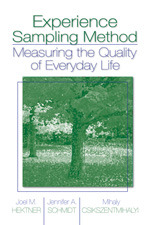List of Tables and Figures
Acknowledgments
Part I: The Origins of ESM
Chapter 1: Epistemological Foundations for the Measurement of Experience
A Systematic Phenomenology
The Experience Sampling Method
How Trustworthy Are Subjective Self-Reports?
What Can We Learn From ESM?
Chapter 2: Theoretical Foundations of ESM
Biology, Culture, and Daily Behavior
Subjective Experience in Context: The Interplay of Psychological Processes and Cognitive Functions
Interaction of Individuals and Environments
Experience Fluctuations, Well-Being, and Development
A Theoretical Compass for Exploring Experience
Part II: How to Measure the Quality of Everyday Life
Chapter 3: Collecting the Data
Designing a Study Using ESM
Equipment and Signaling Schedules
Chapter 4: Dealing With the Data: Coding, Entry, Cleaning, and Data Management
Coding the External Coordinates of Experience
Conding the Internal Coordinates of Experience
What to Do With the Codes Once They Are Developed: Physically Coding and Entering the Data
Setup, Cleaning, and Manipulation of Data Files
Response-Level Data and Person-Level Data
Postentry Data Manipulation
Data File Management and Documentation
Chapter 5: Types of Analyses
Graphic and Numeric Descriptive Information
Planning for Statistical Analyses
OLS Statistical Techniques
Multilevel and Other Complex Statistical Techniques
Chapter 6: Psychometrics of ESM Data
Validity of ESM Measurements
Reliability of ESM Measurements
Part III: Uses of ESM in Social Science Research
Chapter 7: Samples of Experience
The Who, What, Where, When, and How of Daily Experiences
Quality of Experience in Selected Activities
Quality of Experience of Selected Groups of People
Emotions, Well-Being, and Flow
Chapter 8: The Experience of Males and Females
Differences in Activities
Differences in Companionship
Similiarities and Differences in Emotional Experience
Other Gender Differences in Adolescence
Chapter 9: The Experience of Family Life
Methodological Concerns and Variations
The Arrival of the First Child
Juggling Work and Family Roles
The Adolescent's Experience of Family
Transmission of Emotions Between Family Members
Comparisons Between Families: Optimal Conditions for Adolescent Development
Chapter 10: The Experience of Work
Methodological Concerns and Variations
The Quality of Experience at Work: General Trends
The Quality of Experience Across Workers
The Quality of Experience Across Work Activities
The Intersection of Work and Family
The Experience of Unemployment
Chapter 11: Examining Cross-Cultural Differences
Methodological Concerns and Variations
Cross-Cultural Variation in General Affective Experience
Culture and Subjective Experience in Various Activities
Cross-Cultural Examination of Flow
Studies of American Subcultures
Chapter 12: Educational Applications
Methodological Concerns and Variations
Time Use and Structure of Classrooms
The Quality of Students' Classroom Experiences
Comparing Students' Classroom Experiences
Studies of Adult Learners
The Experience of Teachers
Chapter 13: Clinical Applications
Methodological Concerns and Variations
Use of ESM for Describing and Contextualizing Experiences of Disorder
Use of ESM in Therapy and in Treatment Evaluation
Concluding Thoughts
Ten Major Issues ESM Illuminates
Appendix A: Sample ESM Data Collection Forms (ESFs)
Appendix B: ESM Coding Scheme Used in the Sloan Study of Youth and Social Development
References
Index
About the Authors

